 | –≠–ª–µ–∫—Ç—Ä–æ–Ω–Ω—ã–π –∫–æ–º–ø–æ–Ω–µ–Ω—Ç: WM2618ID | –°–∫–∞—á–∞—Ç—å:  PDF PDF  ZIP ZIP |
Document Outline
- WM2618
- Dual 12-bit Serial Input Voltage Output DAC
- Production Data, October 2000, Rev 1.1
- FEATURES
- DESCRIPTION
- APPLICATIONS
- ORDERING INFORMATION
- BLOCK DIAGRAM
- TYPICAL PERFORMANCE
- PIN CONFIGURATION
- PIN DESCRIPTION
- ABSOLUTE MAXIMUM RATINGS
- RECOMMENDED OPERATING CONDITIONS
- ELECTRICAL CHARACTERISTICS
- TYPICAL PERFORMANCE GRAPHS
- DEVICE DESCRIPTION
- GENERAL FUNCTION
- SERIAL INTERFACE
- SOFTWARE CONFIGURATION OPTIONS
- PACKAGE DIMENSIONS
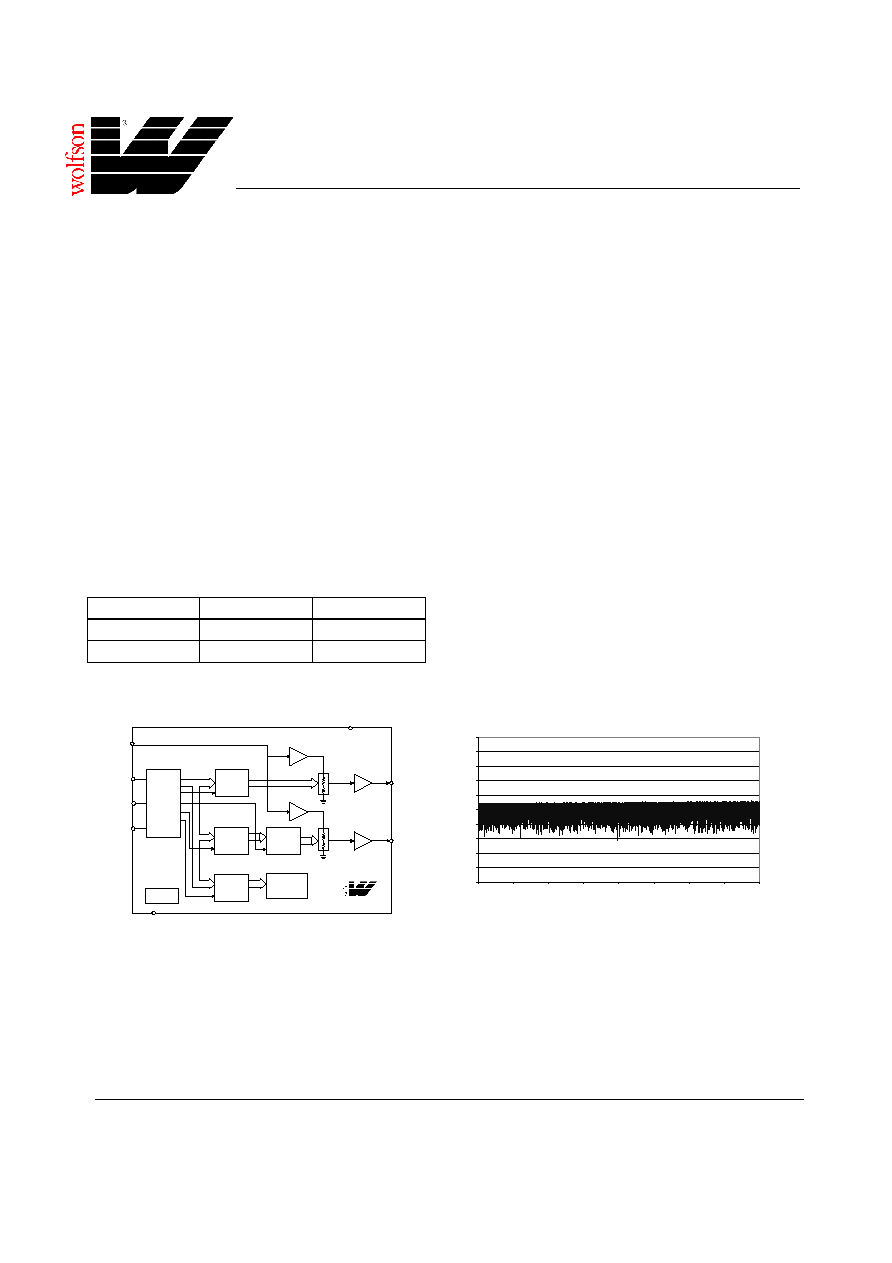
WM2618
Dual 12-bit Serial Input Voltage Output DAC
Production Data, October 2000, Rev 1.1
WOLFSON MICROELECTRONICS LTD
Lutton Court, Bernard Terrace, Edinburgh, EH8 9NX, UK
Tel: +44 (0) 131 667 9386
Fax: +44 (0) 131 667 5176
Email: sales@wolfson.co.uk
http://www.wolfson.co.uk
Production Data datasheets contain final
specifications current on publication date.
Supply of products conforms to Wolfson
Microelectronics' Terms and Conditions.
2000 Wolfson Microelectronics Ltd
.
FEATURES
∑
Two 12-bit voltage output DACs
∑
Single supply from 2.7V to 5.5V supply operation
∑
DNL
±
0.5 LSB, INL
±
1.9
∑
Low power consumption
- 3mW typical in slow mode
- 8mW typical in fast mode
∑
TMS320, (Q)SPI
, and Microwire
compatible
serial interface
∑
Programmable settling time 4
µ
s or 12
µ
s typical
APPLICATIONS
∑
Battery powered test instruments
∑
Digital offset and gain adjustment
∑
Battery operated/remote industrial controls
∑
Machine and motion control devices
∑
Cellular telephones
∑
Wireless telephone and communication systems
∑
Speech synthesis
∑
Arbitrary waveform generation
ORDERING INFORMATION
DEVICE
TEMP. RANGE
PACKAGE
WM2618CD
0∞ to 70∞C
8-pin SOIC
WM2618ID
-40∞ to 85∞C
8-pin SOIC
DESCRIPTION
The WM2618 is a dual 12-bit voltage output, resistor string,
digital-to-analogue converter. A power-on-reset function
ensures repeatable start-up conditions.
The device has been designed to interface efficiently to industry
standard microprocessors and DSPs, including the TMS320
family. The WM2618 is programmed with a 16-bit serial word.
The WM2618 has a simple-to-use single 2.7V to 5.5V supply.
The digital inputs feature Schmitt triggers for high noise
immunity.
The number of clocks from the falling edge of NCS are counted
automatically. The device is then updated and disabled from
accepting further data inputs.
Excellent performance is delivered with a typical DNL of ±0.5
LSBs. The settling time of the DAC is programmable to allow
the designer to optimise speed versus power dissipation.
The device is available in an 8-pin SOIC package ideal for
space-critical applications. Commercial temperature (0∞ to
70∞C) and Industrial temperature (-40∞ to 85∞C) variants are
supported.
BLOCK DIAGRAM
TYPICAL PERFORMANCE
(7) OUTB
(4) OUTA
12-BIT
DAC B
HOLDING
LATCH
12-BIT
DAC A
LATCH
REFIN(6)
POWER-ON
RESET
DIN (1)
SCLK (2)
NCS (3)
(5)
AGND
VDD
(8)
POWERDOWN/
SPEED
CONTROL
12-BIT
DAC B
CONTROL
LATCH
DAC
OUTPUT
BUFFER
2-BIT
CONTROL
LATCH
X1
X1
X2
X2
DAC
OUTPUT
BUFFER
REFERENCE
INPUT BUFFER
REFERENCE
INPUT BUFFER
WM2618
16-BIT
SHIFT
REGISTER
AND
CONTROL
LOGIC
data
5V = VDD, V
REF
= 2.048V, Speed = Fast mode, Load = 10k/100pF
-1
-0.8
-0.6
-0.4
-0.2
0
0.2
0.4
0.6
0.8
1
0
512
1024
1536
2048
2559
3071
3583
4095
DIGITAL CODE
DNL
-
L
S
B
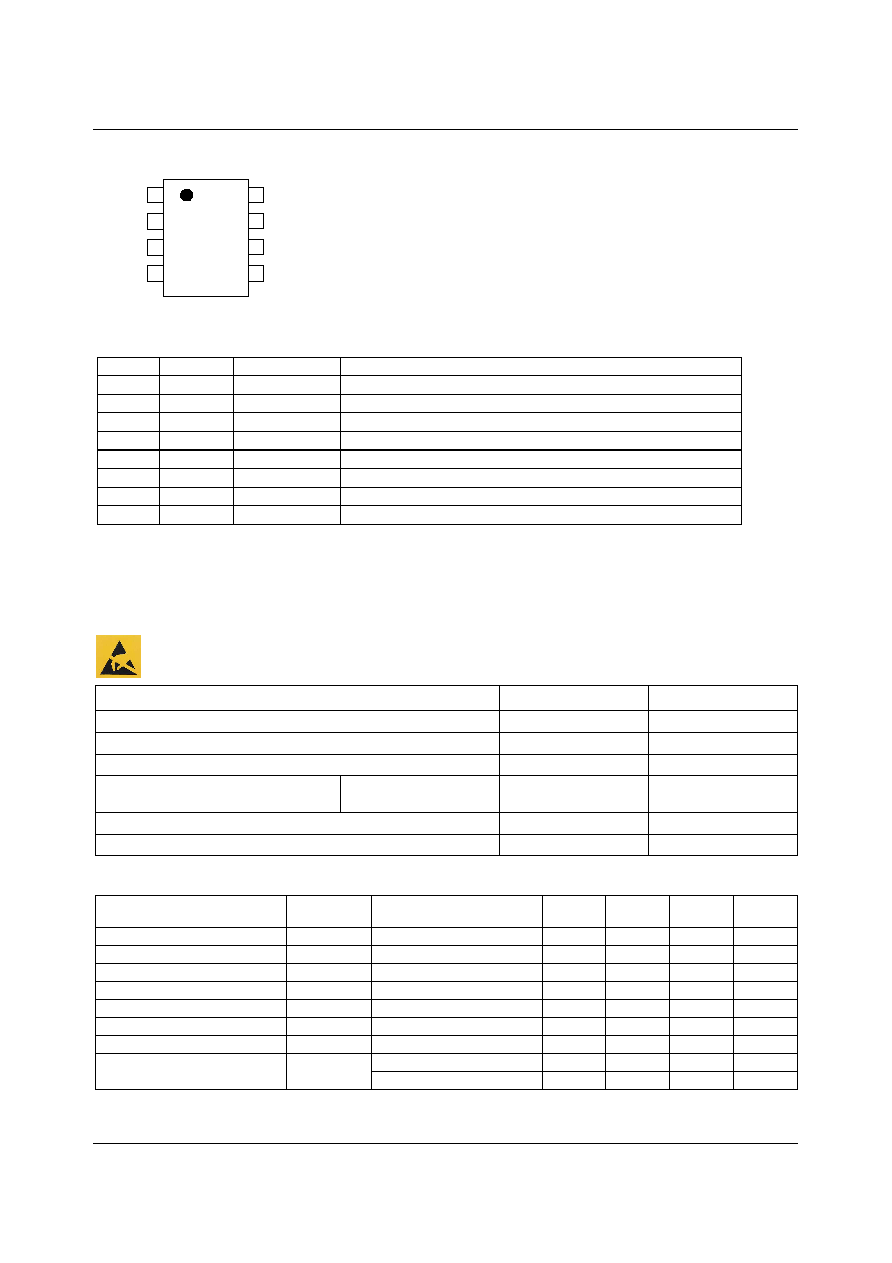
WM2618
Production Data
WOLFSON MICROELECTRONICS LTD
PD
Rev 1.1 October 2000
2
PIN CONFIGURATION
1
2
3
4
NCS
DIN
SCLK
AGND
REFIN
OUTB
VDD
OUTA
5
6
7
8
PIN DESCRIPTION
PIN NO
NAME
TYPE
DESCRIPTION
1
DIN
Digital input
Serial data input.
2
SCLK
Digital input
Serial clock input.
3
NCS
Digital input
Chip select. This pin is active low.
4
OUTA
Analogue output
DAC A analogue output.
5
AGND
Supply
Analogue ground.
6
REFIN
Analogue input
Voltage reference input.
7
OUTB
Analogue output
DAC B analogue output
8
VDD
Supply
Positive power supply.
ABSOLUTE MAXIMUM RATINGS
Absolute Maximum Ratings are stress ratings only. Permanent damage to the device may be caused by continuously operating at
or beyond these limits. Device functional operating limits and guaranteed performance specifications are given under Electrical
Characteristics at the test conditions specified
ESD Sensitive Device. This device is manufactured on a CMOS process. It is therefore generically susceptible
to damage from excessive static voltages. Proper ESD precautions must be taken during handling and storage
of this device.
CONDITION
MIN
MAX
Supply voltage, VDD to AGND
7V
Digital input voltage
-0.3V
VDD + 0.3V
Reference input voltage
-0.3V
VDD + 0.3V
Operating temperature range, T
A
WM2618C
WM2618I
0
∞
C
-40
∞
C
70
∞
C
85
∞
C
Storage temperature
-65
∞
C
150
∞
C
Lead temperature 1.6mm (1/16 inch) soldering for 10 seconds
260
∞
C
RECOMMENDED OPERATING CONDITIONS
PARAMETER
SYMBOL
TEST CONDITIONS
MIN
TYP
MAX
UNIT
Supply voltage
VDD
2.7
5.5
V
High-level digital input voltage
V
IH
2
V
Low-level digital input voltage
V
IL
0.8
V
Reference voltage to REFIN
V
REF
VDD - 1.5
V
Load resistance
R
L
2
k
Load capacitance
C
L
100
Serial clock rate
fSCLK
20
WM2618C
0
70
∞C
Operating free-air temperature
T
A
WM2618I
-40
85
∞C
Note: Reference voltages greater than VDD/2 will cause saturation for large DAC codes.
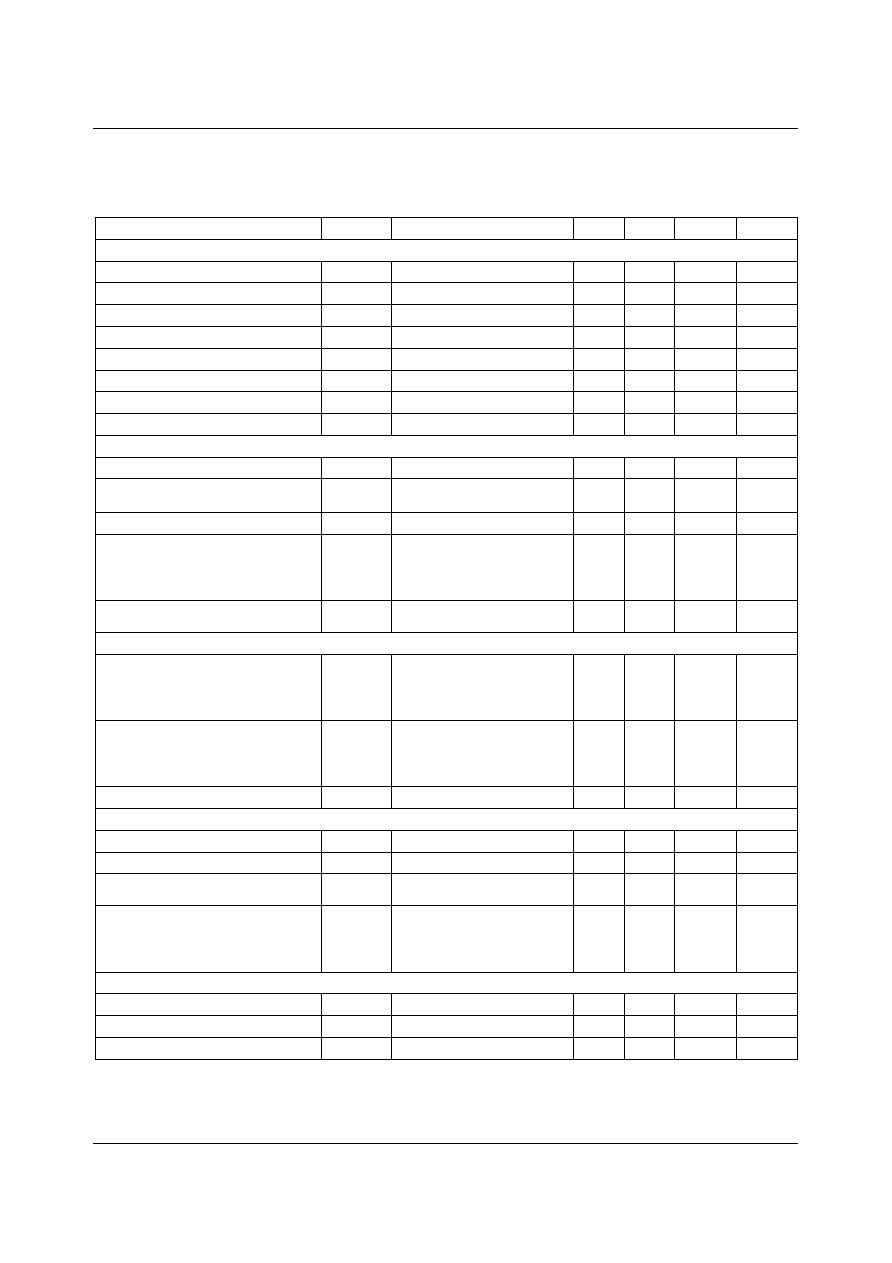
Production Data
WM2618
WOLFSON MICROELECTRONICS LTD
PD Rev 1.1 October 2000
3
ELECTRICAL CHARACTERISTICS
Test Conditions:
R
L
= 10k
, C
L
= 100pF. VDD
= 5V
±
10%, V
REF
= 2.048V and VDD
= 3V
±
10%, V
REF
= 1.024V over recommended operating
free-air temperature range (unless noted otherwise)
PARAMETER
SYMBOL
TEST CONDITIONS
MIN
TYP
MAX
UNIT
Static DAC Specifications
Resolution
12
bits
Integral non-linearity
INL
See Note 1
±
1.9
±
4
LSB
Differential non-linearity
DNL
See Note 2
±
0.5
±
1
LSB
Zero code error
ZCE
See Note 3
3
±
12
mV
Gain error
GE
See Note 4
0.1
±
0.6
% FSR
D.c. power supply rejection ratio
DC PSRR
See Note 5
0.5
mV/V
Zero code error temperature coefficient
See Note 6
10
ppm/
∞
C
Gain error temperature coefficient
See Note 6
10
ppm/
∞
C
DAC Output Specifications
Output voltage range
0
VDD - 0.1
V
Output load regulation
2k
to 10k
load
See Note 7
0.1
0.3
%
Power Supplies
Active supply current
I
DD
No load, V
IH
= VDD, V
IL
= 0V
VDD = 5.5V, V
REF
= 2.048V Slow
VDD
= 5.5V, V
REF
= 2.048V Fast
See Note 8
0.6
1.6
1.0
2.5
mA
mA
Power down supply current
No load,
all digital inputs 0V or VDD
0.01
µ
A
Dynamic DAC Specifications
Slew rate
AC code 128 to 4095, 10%-90%
Slow
Fast
See Note 9
0.3
2.4
0.5
3.0
V/
µ
s
V/
µ
s
Settling time
DAC code 128 to 4095
Slow
Fast
See Note 10
12.0
4.0
µ
s
µ
s
Glitch energy
Code 2047 to 2048
10
nV-s
Reference
Reference input resistance
R
REFIN
10
M
Reference input capacitance
C
REFIN
5
pF
Reference feedthrough
V
REF
= 1VPP at 1kHz
+ 1.024V dc, DAC code 0
-60
dB
Reference input bandwidth
V
REF
= 0.2VPP + 1.024V dc
DAC code 2048
Slow
Fast
0.5
1.0
MHz
MHz
Digital Inputs
High level input current
I
IH
Input voltage = VDD
1
µ
A
Low level input current
I
IL
Input voltage = 0V
-1
µ
A
Input capacitance
C
I
8
pF
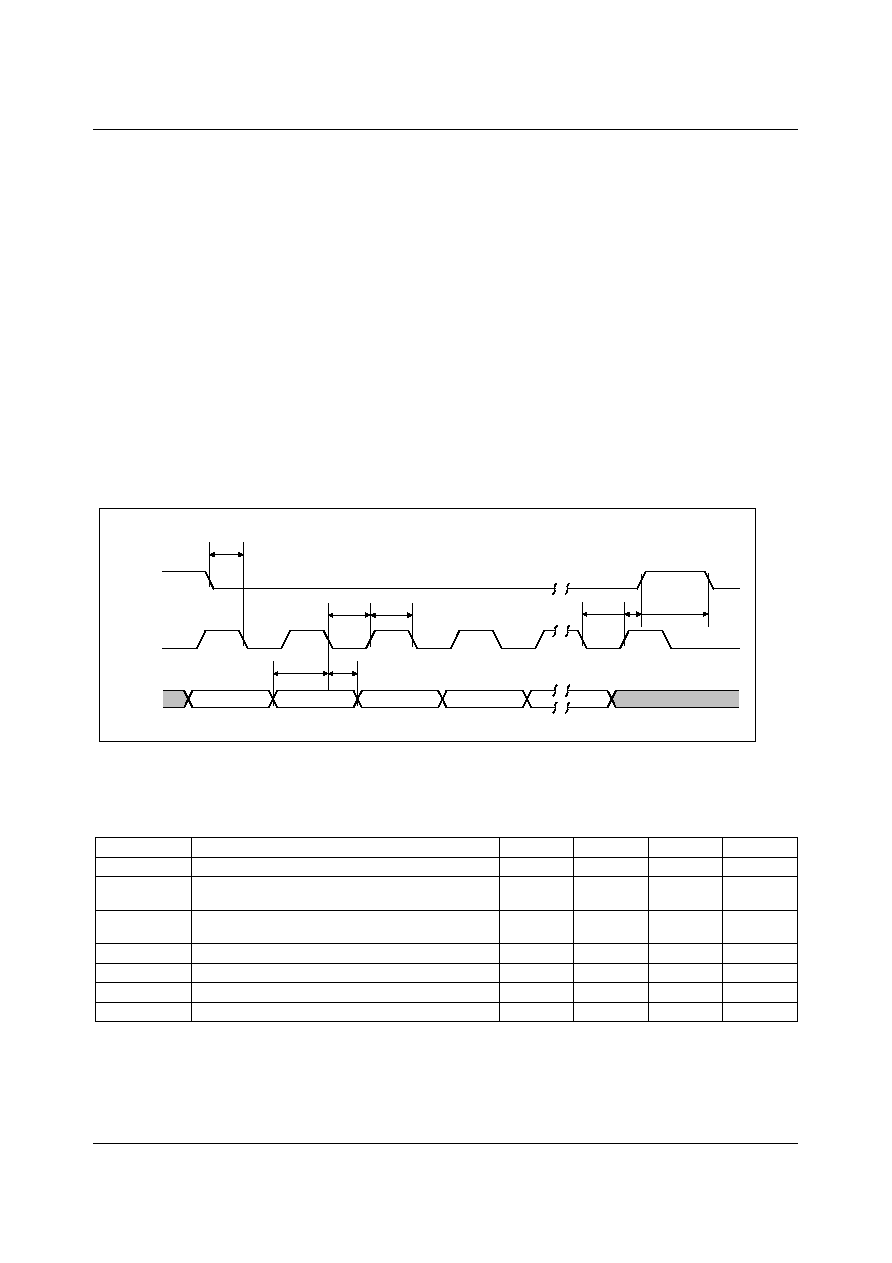
WM2618
Production Data
WOLFSON MICROELECTRONICS LTD
PD
Rev 1.1 October 2000
4
Notes:
1.
Integral non-linearity (INL) is the maximum deviation of the output from the line between zero and full scale
(excluding the effects of zero code and full scale errors).
2.
Differential non-linearity (DNL) is the difference between the measured and ideal 1LSB amplitude change of any
adjacent two codes. A guarantee of monotonicity means the output voltage changes in the same direction (or
remains constant) as a change in digital input code.
3.
Zero code error is the voltage output when the DAC input code is zero.
4.
Gain error is the deviation from the ideal full scale output excluding the effects of zero code error.
5.
Power supply rejection ratio is measured by varying VDD from 4.5V to 5.5V and measuring the proportion of this
signal imposed on the zero code error and the gain error.
6.
Zero code error and Gain error temperature coefficients are normalised to full scale voltage.
7.
Output load regulation is the difference between the output voltage at full scale with a 10k
load and 2k
load. It
is expressed as a percentage of the full scale output voltage with a 10k
load.
8.
I
DD
is measured while continuously writing code 2048 to the DAC. For V
IH
< VDD - 0.7V and V
IL
> 0.7V supply
current will increase.
9.
Slew rate results are for the lower value of the rising and falling edge slew rates.
10.
Settling time is the time taken for the signal to settle to within 0.5LSB of the final measured value for both rising
and falling edges. Limits are ensured by design and characterisation, but are not production tested.
SERIAL INTERFACE
NCS
SCLK
DIN
D15
D14
D13
D12
D11
D0
t
SUCSS
t
WCL
t
WCH
t
SUCS1
t
SUCS2
t
HDCLK
t
SUDCLK
Figure 1 Timing Diagram
Test Conditions:
R
L
= 10k
, C
L
= 100pF. VDD
= 5V
±
10%, V
REF
= 2.048V and VDD
= 3V
±
10%, V
REF
= 1.024V over recommended
operating free-air temperature range (unless noted otherwise)
SYMBOL
TEST CONDITIONS
MIN
TYP
MAX
UNIT
t
SUCSS
Setup time NCS low before SCLK low
5
ns
t
SUSCS1
Setup time, falling edge of SCLK to rising edge of
NCS, external end of write
10
ns
t
SUSCS2
Setup time, rising edge of SCLK to falling edge of
NCS, start of next write cycle
5
ns
t
WCL
Pulse duration, SCLK high
25
ns
t
WCH
Pulse duration, SCLK low
25
ns
t
SUDCLK
Setup time, data ready before SCLK falling edge
5
ns
t
HDCLK
Hold time, data held valid after SCLK falling edge
5
ns

Production Data
WM2618
WOLFSON MICROELECTRONICS LTD
PD Rev 1.1 October 2000
5
TYPICAL PERFORMANCE GRAPHS
5V = VDD, V
REF
= 2.048V, Speed = Fast mode, Load = 10k/100pF
-3
-2
-1
0
1
2
3
0
512
1024
1536
2048
2559
3071
3583
4095
DIGITAL CODE
I
N
L - LS
B
Figure 2 Integral Non-Linearity
0
0.05
0.1
0.15
0.2
0.25
0.3
0.35
0.4
0
1
2
3
4
5
6
7
8
9
10
ISINK- mA
OU
TP
U
T
V
O
LTA
GE
-
V
Slow
Fast
VDD = 3V, V
REF
= 1V, Input Code = 0
0
0.05
0.1
0.15
0.2
0.25
0.3
0.35
0.4
0
1
2
3
4
5
6
7
8
9
10
ISINK - mA
OU
TP
U
T
V
O
LTA
GE
-
V
Slow
Fast
VDD = 5V, V
REF
= 2V, Input Code = 0
Figure 3 Sink Current VDD = 3V
Figure 4 Sink Current VDD = 5V
2.02
2.025
2.03
2.035
2.04
2.045
2.05
2.055
2.06
0
1
2
3
4
5
6
7
8
9
10
11
ISOURCE- mA
OU
TP
U
T
V
O
LTA
GE
-
V
Slow
Fast
VDD = 3V, V
REF
= 1V, Input Code = 4095
4.06
4.065
4.07
4.075
4.08
4.085
4.09
4.095
4.1
0
1
2
3
4
5
6
7
8
9
10
11
ISOURCE - mA
OU
TP
U
T
V
O
LTA
GE
-
V
Slow
Fast
VDD = 5V, V
REF
= 2V, Input Code = 4095
Figure 5 Source Current VDD = 3V
Figure 6 Source Current VDD = 5V
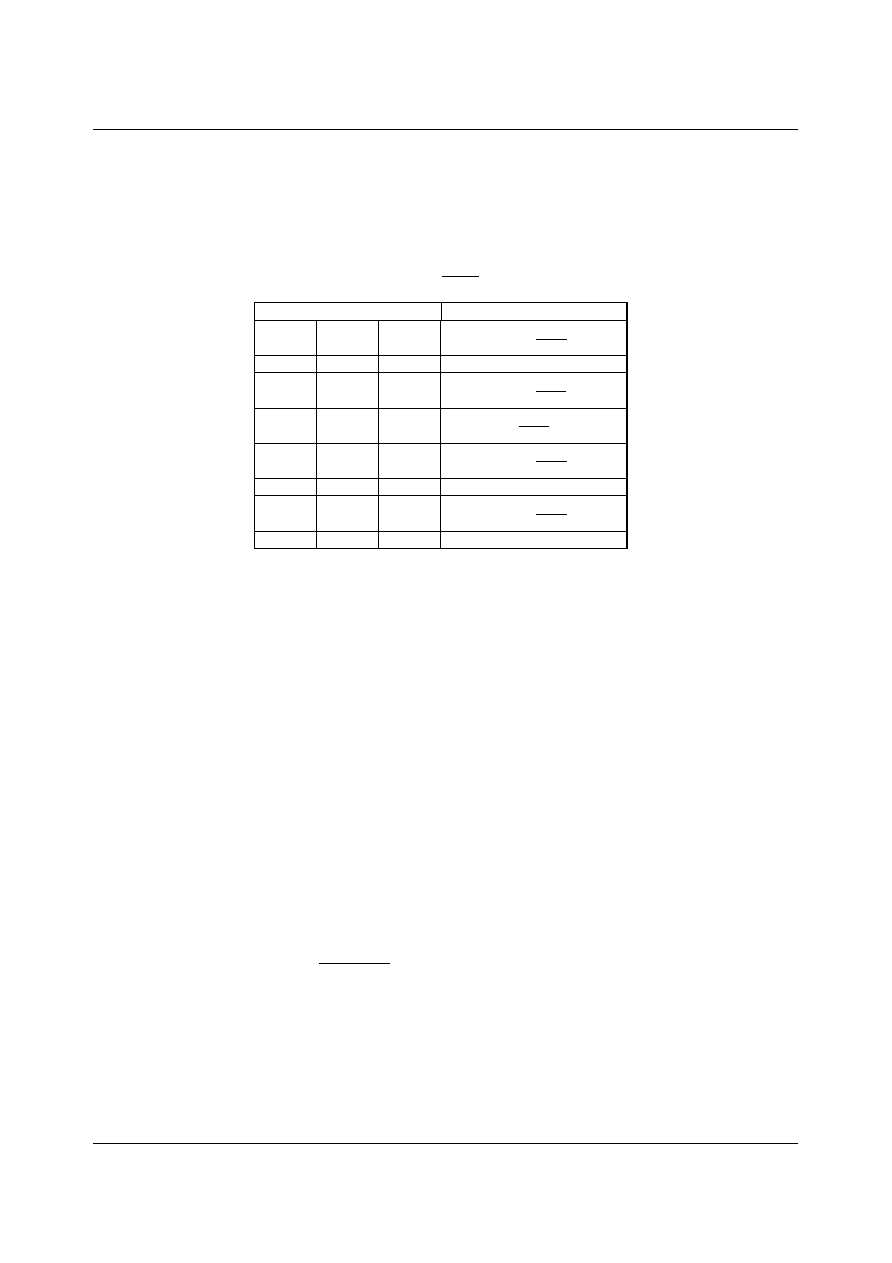
WM2618
Production Data
WOLFSON MICROELECTRONICS LTD
PD
Rev 1.1 October 2000
6
DEVICE DESCRIPTION
GENERAL FUNCTION
The device uses a resistor string network buffered with an op amp to convert 12-bit digital
data to analogue voltage levels (see Block Diagram). The output voltage is determined by the
reference input voltage and the input code according to the following relationship:
Output voltage =
( )
4096
CODE
V
2
REF
INPUT
OUTPUT
1111
1111
1111
( )
4096
4095
V
2
REF
:
:
1000
0000
0001
( )
4096
2049
V
2
REF
1000
0000
0000
( )
REF
REF
V
4096
2048
V
2
=
0111
1111
1111
( )
4096
2047
V
2
REF
:
:
0000
0000
0001
( )
4096
1
V
2
REF
0000
0000
0000
0V
Table 1 Binary Code Table (0V to 2V
REFIN
Output), Gain = 2
POWER ON RESET
An internal power-on-reset circuit resets the DAC registers to all 0s on power-up.
BUFFER AMPLIFIER
The output buffer has a near rail-to-rail output with short circuit protection and can reliably
drive a 2k
load with a 100pF load capacitance.
EXTERNAL REFERENCE
The reference voltage input is buffered which makes the DAC input resistance independent
of code. The REFIN input resistance is 10M
and the REFIN input capacitance is typically
5pF. The reference voltage determines the DAC full-scale output.
SERIAL INTERFACE
When chip select (NCS) is low, the input data is read into a 16-bit shift register with the input
data clocked in most significant bit first. The falling edge of the SCLK input shifts the data
into the input register. After 16 bits have been transferred, the next rising edge on SCLK or
NCS then transfers the data to the DAC latch. When NCS is high, input data cannot be
clocked into the input register (see Table 2).
SERIAL CLOCK AND UPDATE RATE
Figure 1 shows the device timing. The maximum serial rate is:
f
SCLK
max =
MHz
20
t
t
1
min
WCL
min
WCH
=
+
The digital update rate is limited to an 800ns period, or 1.25MHz frequency. However, the
DAC settling time to 12 bits limits the update rate for large input step transitions.

Production Data
WM2618
WOLFSON MICROELECTRONICS LTD
PD Rev 1.1 October 2000
7
SOFTWARE CONFIGURATION OPTIONS
The 16 bits of data can be transferred with the sequence shown in Table 2. D11-D0 contains the 12-
bit data word. D15-D12 hold the programmable options which are summarized in Table 3.
D15
D14
D13
D12
D11
D10
D9
D8
D7
D6
D5
D4
D3
D2
D1
D0
Program Bits
New DAC value
Table 2 Serial Word Format
PROGRAM BITS
D15
D14
D13
D12
DEVICE FUNCTION
1
X
X
X
Write to latch A with serial interface register data and
latch B updated with buffer latch data.
0
X
X
0
Write to latch B and double buffer latch.
0
X
X
1
Write to double buffer latch only.
X
0
X
X
12
µ
s settling time.
X
1
X
X
4
µ
s settling time.
X
X
0
X
Powered-up operation.
X
X
1
X
Power down mode.
Table 3 Program Bits D15 to D12 Function
PROGRAMMABLE SETTLING TIME
Settling time is a software selectable 12
µ
s or 4
µ
s, typical to within
±
0.5LSB of final value.
This is controlled by the value of D14. A ONE defines a settling time of 4
µ
s, a ZERO defines
a settling time of 12
µ
s.
PROGRAMMABLE POWER DOWN
The power down function is controlled by D13. A ZERO configures the device as active, or
fully powered up, a ONE configures the device into power down mode. When the power
down function is released the device reverts to the DAC code set prior to power down.
FUNCTION OF THE LATCH CONTROL BITS (D15 AND D12)
PURPOSE AND USE OF THE DOUBLE BUFFER
Normally only one DAC output can change after a write. The double buffer allows both DAC
outputs to change after a single write. This is achieved by the two following steps.
∑
A double buffer only write is executed to store the new DAC B data without changing the
DAC A and B outputs.
∑
Following the previous step, a write to latch A is executed. This writes the serial interface
register (SIR) data to latch A and also writes the double buffer contents to latch B. Thus
both DACs receive their new data at the same time and so both DAC outputs begin to
change at the same time.
Unless a double buffer only write is issued, the latch B and double buffer contents are
identical. Thus, following a write to latch A or B with another write to latch A does not change
the latch B contents.
Three data transfer options are possible. All transfers occur immediately after NCS goes high
(or on the sixteenth positive SCLK edge, whichever is earlier) and are described in the
following sections.
LATCH A WRITE, LATCH B UPDATE (D15 = HIGH, D12 = X)
The serial interface register (SIR) data are written to latch A and the double buffer latch
contents are written to latch B. The double buffer contents are unaffected. This program bit
condition allows simultaneous output updates of both DACs.
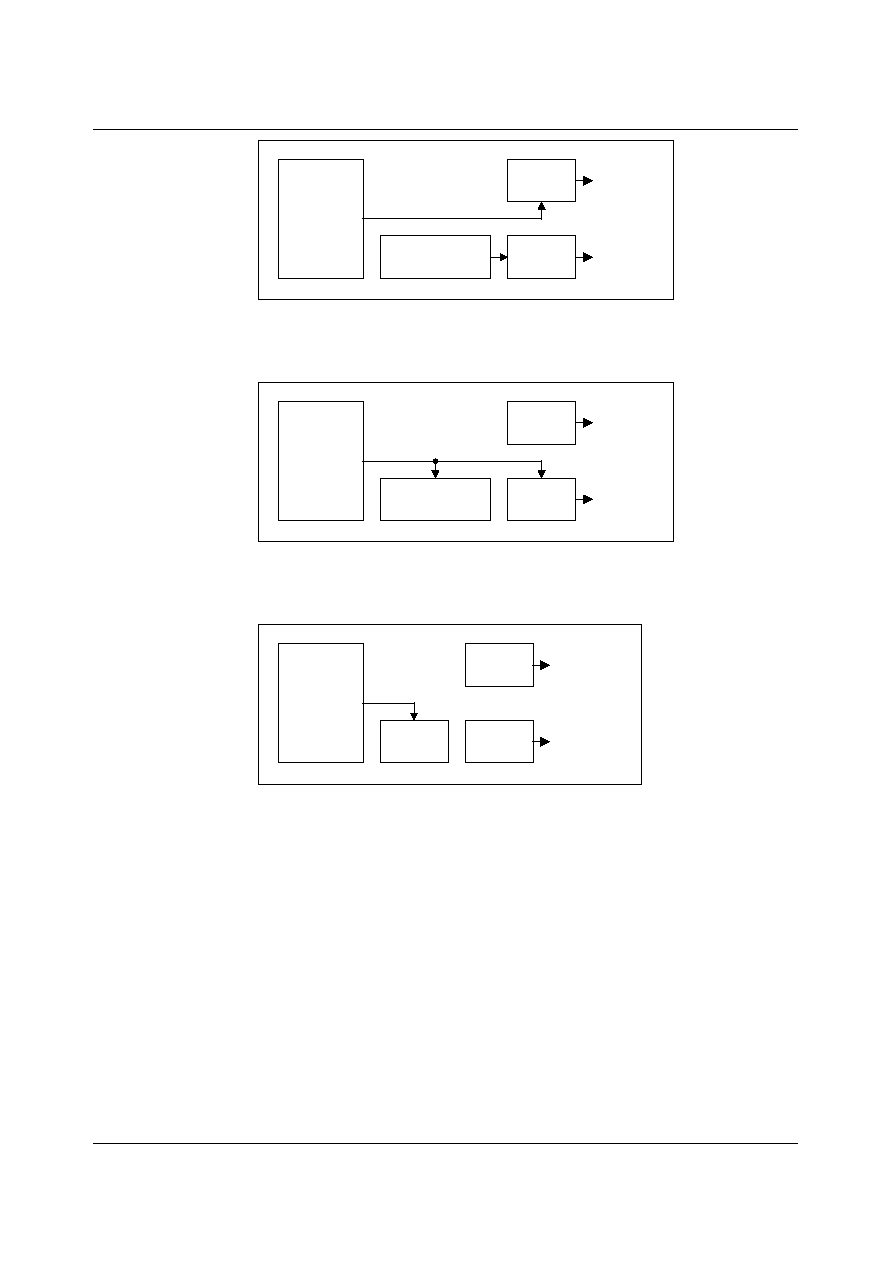
WM2618
Production Data
WOLFSON MICROELECTRONICS LTD
PD
Rev 1.1 October 2000
8
SERIAL
INTERFACE
REGISTER
D12 = X
D15 = HIGH
DOUBLE
BUFFER LATCH
LATCH B
TO DAC B
LATCH A
TO DAC A
Figure 2 Latch A Write, Latch B Update
LATCH B AND DOUBLE BUFFER WRITE (D15 = LOW, D12 = LOW)
The SIR data are written to both latch B and the double buffer. Latch A is unaffected.
SERIAL
INTERFACE
REGISTER
D12 = LOW
D15 = LOW
DOUBLE
BUFFER LATCH
LATCH B
TO DAC B
LATCH A
TO DAC A
Figure 3 Latch B and Double Buffer Write
DOUBLE BUFFER ONLY WRITE (D15 = LOW, D12 = HIGH)
The SIR data are written to the double buffer only. Latch A and B contents are unaffected.
SERIAL
INTERFACE
REGISTER
D12 = HIGH
D15 = LOW
DOUBLE
BUFFER
LATCH B
TO DAC B
LATCH A
TO DAC A
Figure 4 Double Buffer Only Write
OPERATIONAL EXAMPLES
1. changing the latch A data from zero to full code
Assuming that latch A starts at zero code (e.g., after power up), the latch can be filled with 1s
by writing (bit D15 on the left, D0 on the right)
1X0X 1111 1111 1111
to the serial interface. Bit D14 can be zero to select slow mode or one to select fast mode.
The other X can be zero or one (don't care).
The latch B contents and DAC B output are not changed by this write unless the double
buffer contents are different from the latch B contents. This can only be true if the last write
was a double buffer-only write.
2. changing the latch B data from zero to full code
Assuming that latch B starts at zero code (e.g., after power up), the latch can be filled with 1s
by writing (bit D15 on the left, D0 on the right).
0X00 1111 1111 1111

Production Data
WM2618
WOLFSON MICROELECTRONICS LTD
PD Rev 1.1 October 2000
9
to the serial interface. Bit D14 can be zero to select slow mode or one to select fast mode.
The data (bits D0 to D11) are written to both the double buffer and latch B.
The latch A contents and the DAC A output are not changed by this write.
3. double buffered change of both DAC outputs
Assuming that DACs A and B start at zero code (e.g., after power up), if DAC A is to be
driven to mid-scale and DAC B to full-scale, and if the outputs are to begin rising at the same
time, this can be achieved as follows:
First,
0d01 1111 1111 1111
is written (bit D15 on the left, D0 on the right) to the serial interface. This loads the full-scale
code into the double buffer but does not change the latch B contents and the DAC B output
voltage. The latch A contents and the DAC A output are also unaffected by this write
operation.
Changing from fast to slow to fast mode changes the supply current which can glitch the
outputs, and so D14 (designated by d in the above data word) should be set to maintain the
speed mode set by the previous write.
Next,
1d0X 1000 0000 0000
is written (bit D15 on the left, D0 on the right) to the serial interface. The X in bit D12 can be
zero or one (don't care). This writes the mid-scale code (100000000000) to latch A and also
copies the full-scale code from the double buffer to latch B. Both DAC outputs thus begin to
rise after the second write.

WM2618
Production Data
WOLFSON MICROELECTRONICS LTD
PD
Rev 1.1 October 2000
10
PACKAGE DIMENSIONS
DM009.B
D: 8 PIN SOIC 3.9mm Wide Body
Symbols
Dimensions
(mm)
Dimensions
(Inches)
MIN
MAX
MIN
MAX
A
1.35
1.75
0.0532
0.0688
A
1
0.10
0.25
0.0040
0.0098
B
0.33
0.51
0.0130
0.0200
C
0.19
0.25
0.0075
0.0098
D
4.80
5.00
0.1890
0.1968
e
1.27 BSC
0.050 BSC
E
3.80
4.00
0.1497
0.1574
h
0.25
0.50
0.0099
0.0196
H
5.80
6.20
0.2284
0.2440
L
0.40
1.27
0.0160
0.0500
0
o
8
o
0
o
8
o
REF:
JEDEC.95, MS-012
NOTES:
A. ALL LINEAR DIMENSIONS ARE IN MILLIMETERS (INCHES).
B. THIS DRAWING IS SUBJECT TO CHANGE WITHOUT NOTICE.
C. BODY DIMENSIONS DO NOT INCLUDE MOLD FLASH OR PROTRUSION, NOT TO EXCEED 0.25MM (0.010IN).
D. MEETS JEDEC.95 MS-012, VARIATION = AA. REFER TO THIS SPECIFICATION FOR FURTHER DETAILS.
C
h x 45
o
L
A
A1
SEATING PLANE
-C-
0.10 (0.004)
4
1
D
5
8
E
H
B
e









